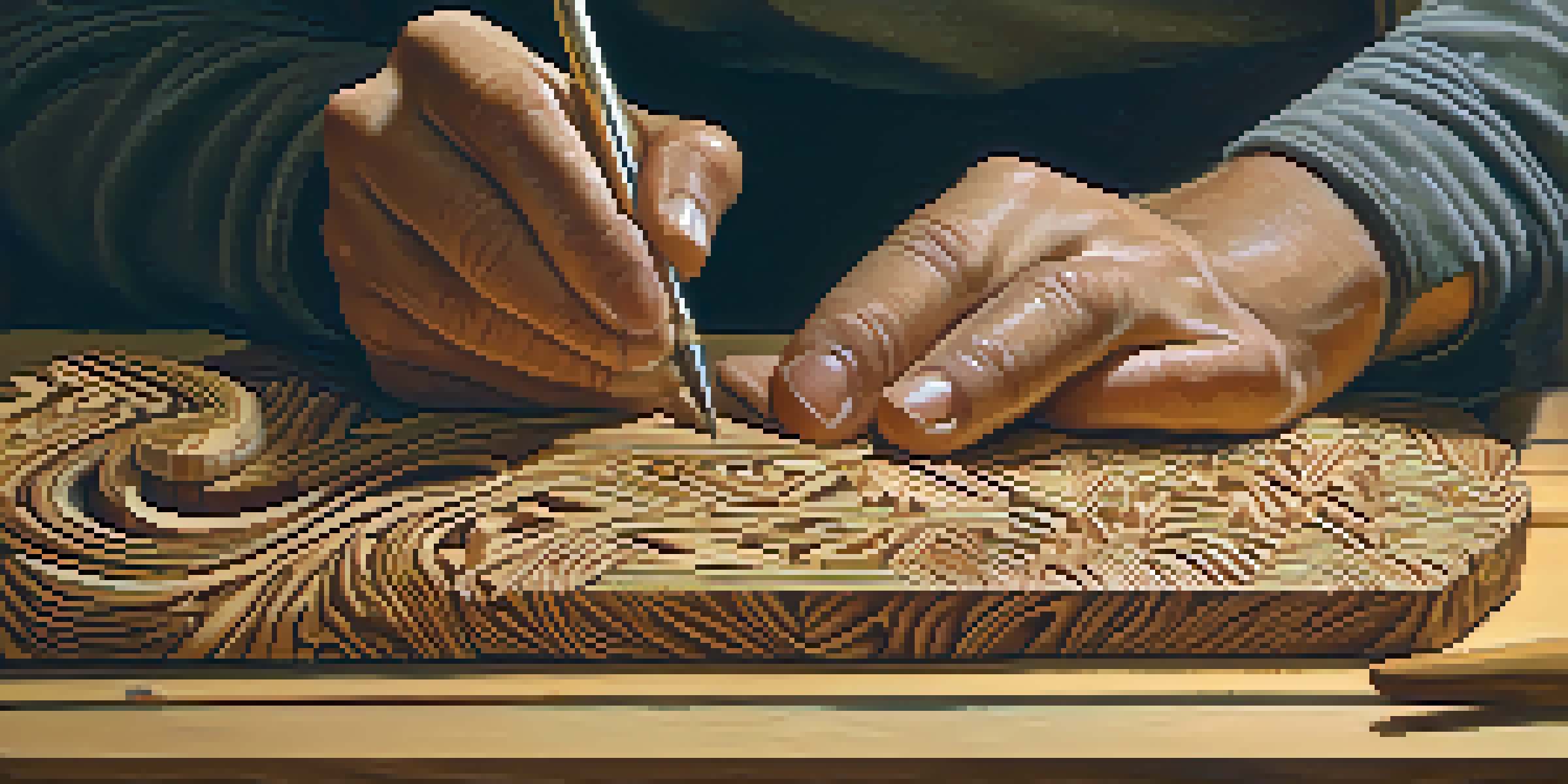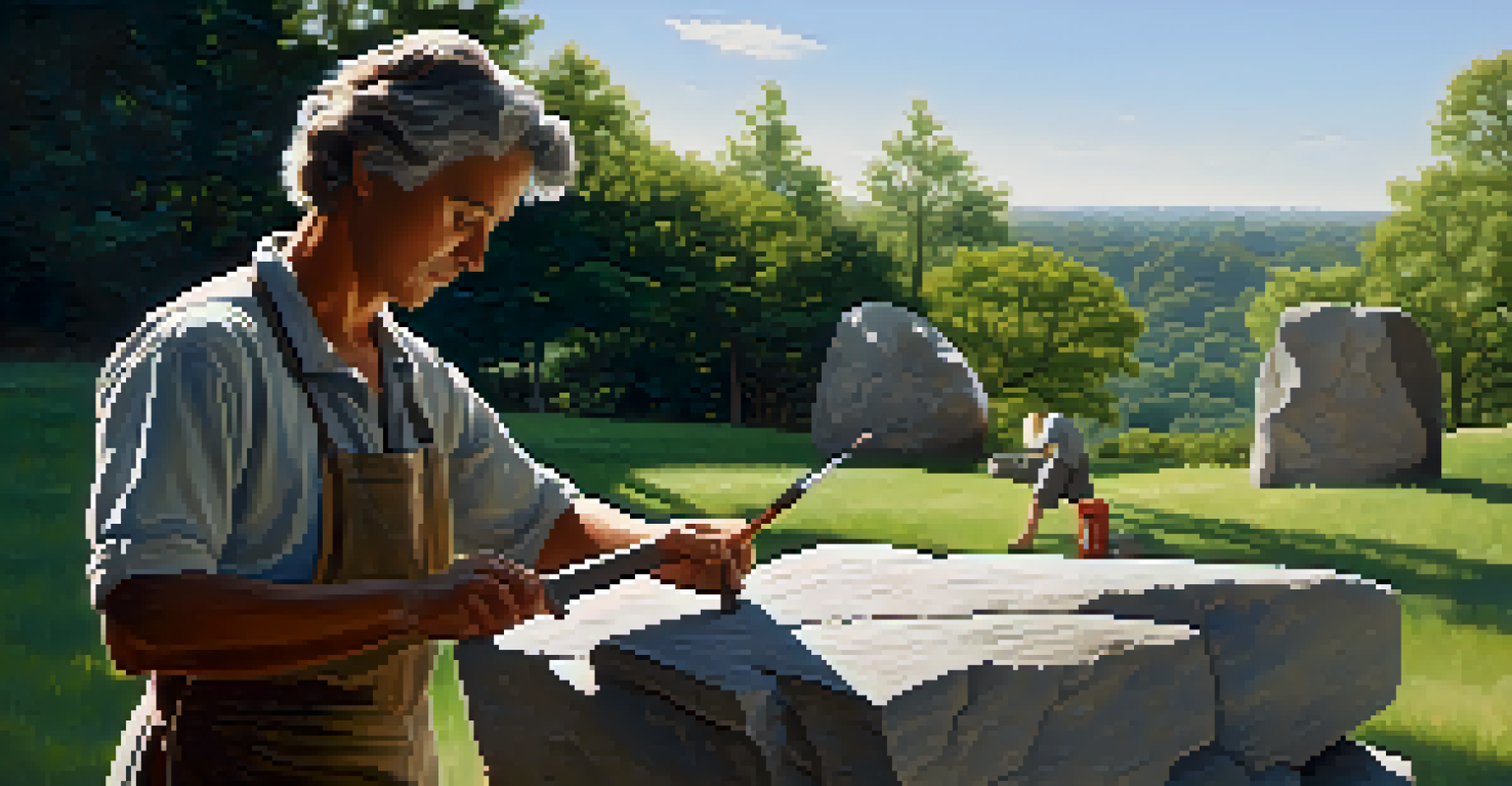Carving and Self-Identity: A Psychological Exploration

Understanding Carving as a Form of Self-Expression
Carving, whether it’s wood, stone, or even ice, is a unique art form that allows individuals to express their inner thoughts and feelings. This creative process not only results in tangible art but also serves as a window into one’s psyche. Just like writing in a journal, carving can provide insight into our emotions and experiences, making the abstract more concrete.
Art is the most beautiful of all lies; it is a way of conveying the truth of our existence.
When someone carves, they engage in a dialogue with the material, and this interaction can reveal personal narratives. Each cut and shape can symbolize different aspects of the artist's life, from struggles to triumphs. In this way, carving becomes a personal history, etched in wood or stone, allowing both the artist and the observer to explore deeper themes of identity.
Moreover, the act of creating something from raw materials can be incredibly empowering. It allows individuals to take control of their surroundings and, in many cases, their stories. This empowerment can lead to enhanced self-esteem and a better understanding of one's self-identity.
The Psychological Benefits of Creative Practices
Engaging in creative practices like carving has been linked to various psychological benefits. For starters, it can serve as a therapeutic outlet, helping individuals process emotions in a healthy way. This is particularly significant for those dealing with stress or trauma, as the physical act of carving can help release pent-up feelings.

Additionally, creativity can stimulate problem-solving skills and critical thinking. As artists navigate the challenges of their medium, they develop resilience and adaptability—skills that are beneficial both in and out of the studio. This not only enhances their carving technique but also translates into everyday life, reinforcing a positive self-identity.
Carving as Self-Expression
Carving serves as a powerful medium for individuals to express their emotions and personal narratives.
Finally, participating in artistic communities can foster a sense of belonging. Sharing one’s work and receiving feedback can create meaningful connections with others, reinforcing one’s self-worth and identity through shared experiences. This communal aspect of carving can remind individuals that they are not alone in their struggles or aspirations.
Cultural Influences on Carving and Identity
Carving can also be viewed through the lens of cultural identity, as different cultures have unique carving traditions that reflect their values and histories. For instance, Indigenous peoples often use carving to tell stories, preserve traditions, and connect with their ancestry. This cultural significance can deepen the artist's connection to their heritage, enriching their self-identity.
The sculptor's art is to make the invisible visible, to give form to the formless.
Moreover, the materials and techniques used in carving can vary widely across cultures, each telling its own story. When artists engage with these traditions, they not only honor their past but also contribute to a living culture, reinforcing their identity as part of a larger community. This interplay between personal expression and cultural heritage can be incredibly powerful.
Interestingly, as globalization continues to influence local practices, artists are blending traditional techniques with modern styles. This fusion creates a unique dialogue between the old and the new, enabling individuals to carve out their own identity in a rapidly changing world. The result is a rich tapestry of self-expression that honors tradition while embracing innovation.
The Role of Emotion in the Carving Process
Emotion plays a pivotal role in the carving process, influencing both the artist’s choices and the final piece. When someone carves with passion, it’s likely that the emotions they are experiencing will manifest in the work itself. This emotional connection can lead to art that resonates deeply with viewers, sparking conversations about shared experiences.
For example, a piece created during a time of grief may evoke feelings of sorrow or nostalgia, while a work made in a joyous moment might radiate energy and happiness. These emotional layers can enhance the complexity of the artwork, allowing it to serve as a medium for exploring self-identity and personal narrative.
Psychological Benefits of Carving
Engaging in carving can enhance emotional processing, boost self-esteem, and foster resilience.
Moreover, reflecting on the emotions that inspire carving can lead to important self-discovery. Artists often find that their work helps them process feelings they may struggle to articulate in words. This introspective journey not only enriches the carving experience but also contributes significantly to their understanding of self.
Carving Identity Through Symbols and Motifs
Symbols and motifs play a crucial role in the carving process, as they can represent various aspects of identity. Artists often infuse their work with personal symbols, whether they are culturally significant or entirely unique to the individual. This practice allows for a deeper exploration of self-identity, as the chosen symbols can reveal hidden meanings and connections.
For instance, a carving that features a specific animal may symbolize particular traits the artist identifies with, such as strength, wisdom, or freedom. These symbols can act as touchstones for self-reflection, enabling the artist to explore their feelings about their identity and life experiences. By examining the choices made in their carvings, individuals can gain insight into their own values and beliefs.
Additionally, the interpretation of symbols can vary from person to person, adding layers of complexity to the artwork. Viewers may find personal significance in the motifs used, leading to a shared sense of understanding and connection. This communal aspect of interpretation can foster discussions about identity, culture, and emotion, further enriching the experience of carving.
Carving as a Tool for Self-Discovery
For many, the act of carving can serve as a pathway to self-discovery. The focused nature of this creative practice allows individuals to escape daily distractions, creating a space for introspection. As they engage with their materials, they can uncover thoughts and emotions that may have lain dormant, leading to personal revelations.
This process of self-discovery can be profound. As artists carve, they may confront challenging emotions or explore aspects of their identity they hadn’t fully acknowledged. This journey can empower individuals to embrace their authentic selves, fostering a stronger sense of self-worth and confidence.
Cultural Identity in Carving
Carving traditions reflect cultural heritage, allowing artists to connect with their ancestry and community.
Ultimately, carving becomes a mirror that reflects not just the artist's work but also their evolving self. By embracing the transformative power of this craft, individuals can carve out their identity in ways that are deeply personal yet universally relatable.
Conclusion: Embracing Identity Through Carving
In conclusion, carving is more than just a creative outlet; it is a powerful tool for exploring and expressing self-identity. Through the act of carving, individuals can engage with their emotions, heritage, and personal narratives, creating a multifaceted understanding of who they are. This journey can foster a sense of empowerment and belonging, reinforcing the idea that our identities are ever-evolving.
As we’ve seen, the psychological benefits of carving extend beyond the individual, impacting communities and fostering connections. Whether through cultural symbols or personal motifs, carving can serve as a bridge that links us to our past and to one another, enriching our shared human experience.

Ultimately, by embracing the art of carving, we can celebrate the complexity of our identities and the stories that shape us. So, pick up a tool, let your emotions flow, and start carving your own unique narrative.